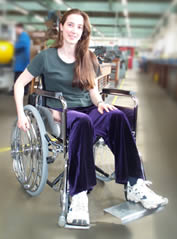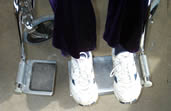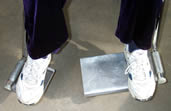Work carried out by a fourth year undergraduate, Lucy Porter, under the supervision of Design Engineer, Samuel Lesley, has led to a new design of manual wheelchair for people with hemiplegia (paralysis of one side of the body).



The inventors are currently seeking licensees to put it into production.
Lucy Porter explains the background the project:
"If you can only use one side of your body, then all the control and propulsive inputs for the wheelchair have to be on one side. The standard NHS hemiplegic wheelchair has two hand rims positioned beside the driving wheel on the active side of the body. To go in a straight line using this system you need to grip both hand rims simultaneously and rotate them at the same speed. However, as you can see from the picture, the rims are relatively widely spaced, which makes them difficult to grip with one hand, especially for people with small hands and little strength. Turning is even more difficult because you use the right hand rim to turn the left wheel and vice versa. This is very counter-intuitive and difficult to get used to, so the chair is rarely used."
The prototype also has two hand-rims on the same side of the chair, but one rim is used for going forwards or backwards, and the other is used for pirouetting on the spot. This drive system is far more ergonomic and easier to learn than existing designs. Travelling in a straight line is automatic; steering is done with a steerable footrest. Tight turns are possible, and there is no difference in the rim force required for turning left or right.
Back-to-back testing of the prototype and the NHS version (with able-bodied triallists, including staff from Addenbrooke's Disablement Services Centre) showed a strong preference for the prototype. However, the triallists recommended some improvements which require another prototype to be built. The improvements are simple to do, but we are looking for a partner to finance the improvements and put the chair into production.
It is a viable product. In the UK there are around 2,000 new cases of hemiplegia per year. About 500 of them could use the Cambridge wheelchair. Realistically, sales in the UK could be 200 p.a.; about 2,000 p.a. in Europe. Patents are pending.
Contact:
Samuel Lesley
Design Engineer
Department of Engineering
University of Cambridge
Trumpington Street
Cambridge
CB2 1PZ
Tel: 01223-332926
Fax:01223-332741
E-mail: sl2@eng.cam.ac.uk Lucy Porter demonstrating the wheelchair design. Steering disengaged (above) and engaged.

